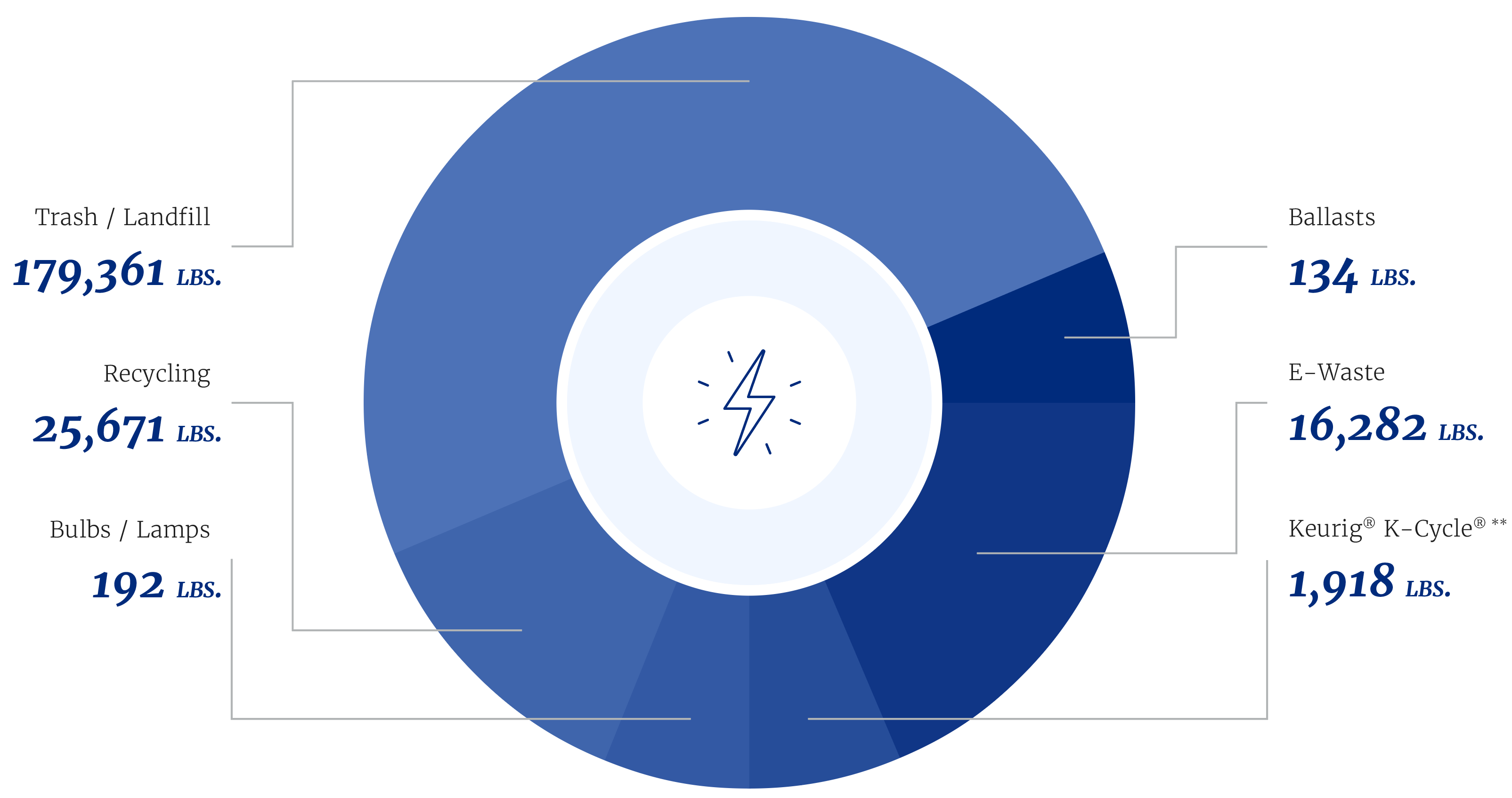Sustaining Our Environment
We are aware of the environmental footprint we leave behind, and we consistently look for ways to reduce our impact — whether that’s through energy usage, waste disposal or land management. Our commitment to the environment is steadfast, and we are proud of the advancements we continue to make across Fulton, along with those of our suppliers and partners, to ensure we leave a legacy for future generations.
Climate Governance & Strategy
We recognize the environmental challenges that face our planet and believe that taking steps to address them in our local communities is an extension of our core value to “Do What is Right.” We are committed to operating our business responsibly with a focus on creating long-term sustainable value for Fulton by increasing revenue, reducing costs, reducing risks, enhancing our reputation, strengthening our communities and working toward meeting the expectations of our shareholders, customers, teammates and communities.
We will continue to support this commitment with our Climate Impact Working Group (CIWG) Pillars:
Pillar 1: BEING AWARE OF, and actively seeking ways to reduce, our operational impact on the environment.
Pillar 2: INCORPORATING climate-related risk management in our business practices.
Pillar 3: ENSURING we have financial products and services that support our clients’ sustainability journeys.
Pillar 4: ENGAGING our suppliers on sustainability.
Paper, Water & Waste Management
WASTE STREAM DIVERSION
Examining how our overall footprint affects the environment, Fulton focused on several waste diversion activities during 2024*.

* Waste diverted or redirected from landfills / traditional disposal throughout 2024.
** A specialty waste diversion program through Keurig’s K-Cycle® Recycling Program.
SPOTLIGHT: CIWG Pillar 1
ENERGY MANAGEMENT & GREENHOUSE GAS EMISSIONS: FULTON PARTNERS WITH JONES LANG LASALLE, INC. (JLL) TO ADVANCE ENVIRONMENTAL SUSTAINABILITY
As part of our ongoing commitment to sustainability, Fulton has partnered with JLL, a leading professional services firm specializing in real estate and investment management.
This collaboration equips Fulton with the expertise and tools to better understand and manage our environmental footprint, particularly in evaluating and reporting on GHG emissions.
Through JLL’s sustainability group, Fulton Bank utilizes these services that have been key to Fulton’s efforts:
- WASTE AUDITS: JLL conducts twice-yearly waste audits at Fulton facilities, helping Fulton identify areas for improvement and adopt more sustainable waste management solutions.
- DESIGN GUIDELINES: JLL works with Fulton to develop design guidelines that prioritize energy efficiency in mechanical, electrical and plumbing systems during construction and renovation.
- ENERGY-EFFICIENT UPGRADES: These upgrades are implemented as opportunities arise and include HVAC, plumbing, lighting and electrical upgrades.
JLL has been quantifying Fulton’s Scope 1 and 2 emissions utilizing their climate data management platform for GHG emissions calculation. The energy team collects all utility bill data from Fulton, ensures completeness via Quality Assurance/Quality Control processes, and uses emissions factors from the Department for Environment, Food and Rural Affairs and Emissions & Generation Integrated Database to calculate overall Scope 1 and 2 emissions for Fulton’s portfolio.

Facilities
Fulton uses various energy-saving and energy-efficient measures within corporate offices and financial centers to minimize our energy consumption and environmental footprint.
Examples of specific areas we invested in during 2024 include HVAC, lighting, plumbing, signage, universal office waste (e.g. batteries), K-Cups® and electrical upgrades.
When building new facilities, we endeavor to satisfy the majority of LEED standards for environmentally certified buildings. Our new construction projects include such standards as Advanced Energy Metering, use of Renewable Energy Production, Enhanced Refrigerant Management and Indoor Water Reduction Usage.
Fulton continues to modernize facilities with heat pump replacement, end of life unit upgrade, burner and oil tank replacement, pneumatic control system replacement and heat exchanger replacement.
FULTON’S FINANCIAL CENTER AT 3.0 UNIVERSITY PLACE EARNS LEED SILVER CERTIFICATION
Fulton is proud that our financial center at 3.0 University Place in West Philadelphia, Pennsylvania received the prestigious LEED Silver Certification for Interior Design & Construction for Retail in July 2024.
This recognition from the U.S. Green Building Council underscores Fulton’s commitment to sustainability and innovation, creating spaces that are energy-efficient, cost-effective and environmentally responsible.
Located in the heart of University City, our 2,250-square-foot financial center is part of the 3.0 University Place development, a 240,000-square-foot research hub and office building. Developed by University Place Associates, the building exemplifies the highest standards of sustainable construction and is designed to serve as a hub for community engagement and innovation.
Our location incorporates innovative design principles to create a welcoming, energy-efficient space. The 17-foot-high glazing and angled ceiling at the entrance allow inviting, natural light to flood the lobby area, reducing reliance on artificial lighting. This thoughtful integration of LEED principles not only enhances the customer experience but also reflects Fulton’s dedication to environmental stewardship.
SHIFTING DEPOSITS TO DIGITAL
Fulton empowers customers to embrace digital banking tools, creating a seamless, efficient experience while supporting environmental sustainability. For example, Fulton offers multiple digital alternatives for deposits, including ATMs, mobile remote deposit capture and remote deposit scanners for business customers.
These options have contributed to a steady shift from in-person transactions to digital channels. It reduces paper waste from deposit slips and the need for transportation to financial centers, furthering our impact on environmental sustainability.
In addition, over 3.8 million potential consumer paper statements were delivered as eStatements. As a result, more than 7.6 million sheets of paper were not printed, further reducing our environmental impact.

